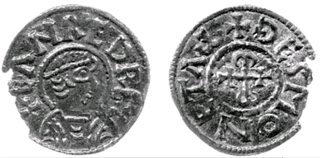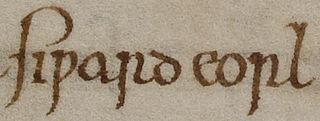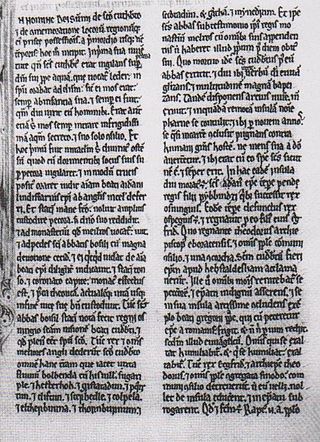Related Research Articles

Northumbria was an early medieval Anglo-Saxon kingdom in what is now Northern England and south-east Scotland.
Bernicia was an Anglo-Saxon kingdom established by Anglian settlers of the 6th century in what is now southeastern Scotland and North East England.
Symeonof Durham was an English chronicler and a monk of Durham Priory.

Eanred was king of Northumbria in the early ninth century.

Siward or Sigurd was an important earl of 11th-century northern England. The Old Norse nickname Digri and its Latin translation Grossus are given to him by near-contemporary texts. It is possible Siward may have been of Scandinavian or Anglo-Scandinavian origin, perhaps a relative of Earl Ulf, although this is speculative. He emerged as a regional strongman in England during the reign of Cnut. Cnut was a Scandinavian ruler who conquered most of England in the 1010s, and Siward was one of many Scandinavians who came to England in the aftermath, rising to become sub-ruler of most of northern England. From 1033 at the latest, he was in control of southern Northumbria, present-day Yorkshire, governing as earl on Cnut's behalf.
Eadulf IV or Eadwulf IV was the earl of Bernicia from 1038 until his death. He was a son of Uhtred the Bold and his second wife Sige, daughter of Styr Ulfsson. Eadwulf had one full sibling, a younger brother Gospatric. He succeeded his older half-brother Ealdred, who was murdered by the son of Thurbrand the Hold in a bloodfeud started when Thurbrand murdered Uhtred. The Anglo-Saxon Chronicle asserts that in 1041 Eadwulf was "betrayed" by King Harthacnut. The "betrayal" seems to have been carried out by Siward, Earl of Northumbria; When the Libellus de Exordio and other sources write about the same event, they say that Siward attacked and killed Eadulf. Siward then became earl of all Northumbria, perhaps the first person to do so since Uhtred the Bold. Eadulf was the last of the ancient Bernician line of earls to rule, until his son Osulf usurped the Northumbrian earldom in 1067.
Eardwulf was king of Northumbria from 796 to 806, when he was deposed and went into exile. He may have had a second reign from 808 until perhaps 811 or 830. Northumbria in the last years of the eighth century was the scene of dynastic strife between several noble families: in 790, king Æthelred I attempted to have Eardwulf assassinated. Eardwulf's survival may have been viewed as a sign of divine favour. A group of nobles conspired to assassinate Æthelred in April 796 and he was succeeded by Osbald: Osbald's reign lasted only twenty-seven days before he was deposed and Eardwulf became king on 14 May 796.

The Libellus de exordio atque procursu istius, hoc est Dunhelmensis, ecclesie, in short Libellus de exordio, is a historical work of marked literary character composed and compiled in the early 12th-century and traditionally attributed to Symeon of Durham. It relates the history of bishopric and church of Durham and its predecessors at Lindisfarne and Chester-le-Street (Cunecacestre). It is sometimes also known as the Historia Dunelmensis ecclesiae.

De primo Saxonum adventu is a historical work, probably written in Durham during the episcopate of Ranulf Flambard (1099–1128). It recounts the coming of the English to Great Britain, treating individually the history of the rulers of the Kingdom of Kent, the Kingdom of East Anglia, the Kingdom of Northumbria, as well as the archbishops of Canterbury and the archbishops of York, the bishops of Durham and the earls of Northumbria.
The Historia Regum is a historical compilation attributed to Symeon of Durham, which presents material going from the death of Bede until 1129. It survives only in one manuscript compiled in Yorkshire in the mid-to-late 12th century, though the material is earlier. It is an often-used source for medieval English and Northumbrian history. The first five sections are now attributed to Byrhtferth of Ramsey.
Eadulf or Eadwulf Rus was an 11th-century Northumbrian noble. He was either the son or grandson of Gospatric, possibly the man who soon after Christmas 1064 was allegedly killed on behalf of Tostig, Earl of Northumbria. This murder by Tostig led to a great northern revolt against Edward the Confessor, a revolt that turned both King Edward and Harold Godwinson against Tostig and led to the appointment of the Mercian, Morcar, as Earl of northern England.
Northman was a late 10th-century English earl, with a territorial base in Northumbria north of the River Tees. A figure with this name appears in two different strands of source material. These are, namely, a textual tradition from Durham witnessed by Historia de Sancto Cuthberto and by the Durham Liber Vitae; and the other an appearance in a witness list of a charter of King Æthelred II dated to 994. The latter is Northman's only appearance south of the Humber, and occurred the year after Northumbria was attacked by Vikings.
Eadred Lulisc or Eadred of Carlisle is the abbot of Carlisle recorded by the Historia de Sancto Cuthberto. The Historia gives the abbot central place in the election of Guthred as king of Northumbria by the Viking army based in Yorkshire, and that subsequently Eadred purchased land from him, using it to endow the bishopric of St Cuthbert. The Historia also related that he and Eardwulf, Bishop of Lindisfarne, moved the body of St Cuthbert away from its previous base at Lindisfarne, tried to take it to Ireland, but failed and took it back to the east, first to Crayke and then to Chester-le-Street.
Thurbrand, nicknamed "the Hold", was a Northumbrian magnate in the early 11th century. Perhaps based in Holderness and East Yorkshire, Thurbrand was recorded as the killer of Uhtred the Bold, Earl of Northumbria. The killing appears to have been part of the war between Sweyn Forkbeard and Cnut the Great against the English king Æthelred the Unready, Uhtred being the latter's chief Northumbrian supporter. Thurbrand may also have attested a charter of 1009 and given a horse to Æthelred's son Æthelstan Ætheling. The killing is the first-known act, if it did not initiate, a bloodfeud between Thurbrand's family and Uhtred going into the time of Earl Waltheof. It is possible that Holderness took its name because of Thurbrand's presence or ownership of the peninsula.
Billfrith is an obscure Northumbrian saint credited with providing the jewel and metalwork encrusting the former treasure binding of the Lindisfarne Gospels. His name is thought to mean "peace of the two-edge sword".

The Historia de Sancto Cuthberto is a historical compilation finished some time after 1031. It is an account of the history of the bishopric of St Cuthbert—based successively at Lindisfarne, Norham, Chester-le-Street and finally Durham—from the life of St Cuthbert himself onwards. The latest event documented is a grant by King Cnut, c. 1031. The work is a cartulary chronicle recording grants and losses of property as well as miracles of retribution, under a loose narrative of temporal progression. The text survives in three manuscripts, the earliest of which dates from around 1100. The original version of the text is not thought to be extant; rather, all surviving manuscripts are thought to be copies of an earlier but lost exemplar. The Historia is one of the sources for the histories produced at Durham in the early 12th century, particularly the Historia Regum and Symeon of Durham's Libellus de Exordio.

Lawrence of Durham was a 12th-century English prelate, Latin poet and hagiographer. Born in southern England, at Waltham in Essex, Lawrence was given a religious education, and excelled at singing and poetry composition. In his youth Lawrence joined Durham Cathedral Priory and became a Benedictine monk. In the 1130s Lawrence became a courtier of Geoffrey Rufus, bishop of Durham.
Cambridge University Library, Ff. i.27 is a composite manuscript at the University of Cambridge. It was formed by adding a 14th-century Bury St Edmunds book to a compendium of material from 12th-century northern England. The latter compendium had once been part of Corpus Christi College Cambridge MS 66. With its original content, it had at one time been at Sawley Abbey, though it was probably produced somewhere else, perhaps Durham. It is a source for the Durham poem, which describes the city and its relics.
Andrew Wareham is a British historian who has written numerous books and articles on Anglo-Saxon history, Anglo-Norman history and the hearth tax. He is employed as a reader in the department of humanities at Roehampton University, London.
A cult of saints played a key part within Anglo-Saxon Christianity, a form of Roman Catholicism practised in Anglo-Saxon England from the late sixth to the mid eleventh century.
References
- ↑ "Sponsored cycle ride by David Rollason". Durham University. Retrieved 3 August 2011.